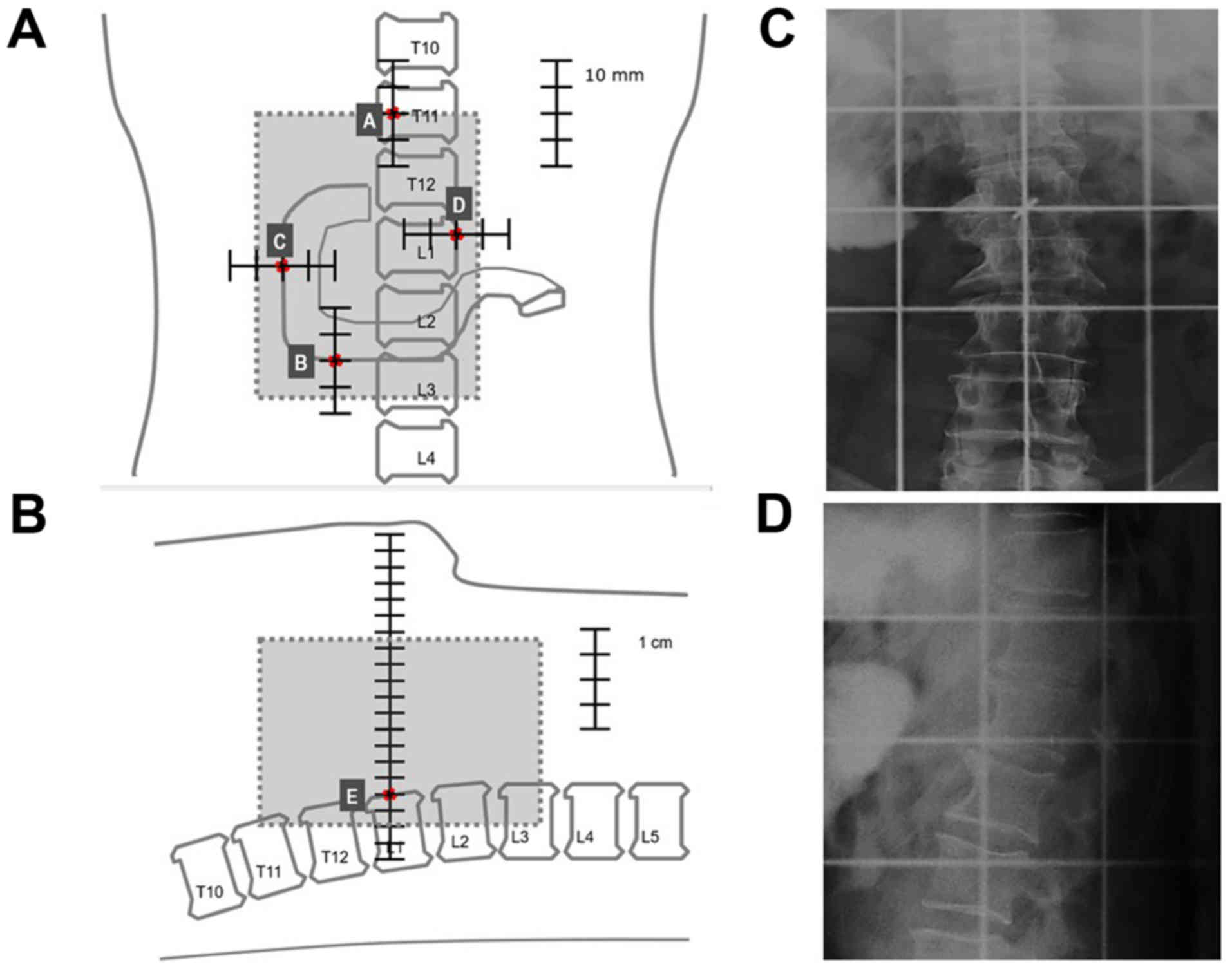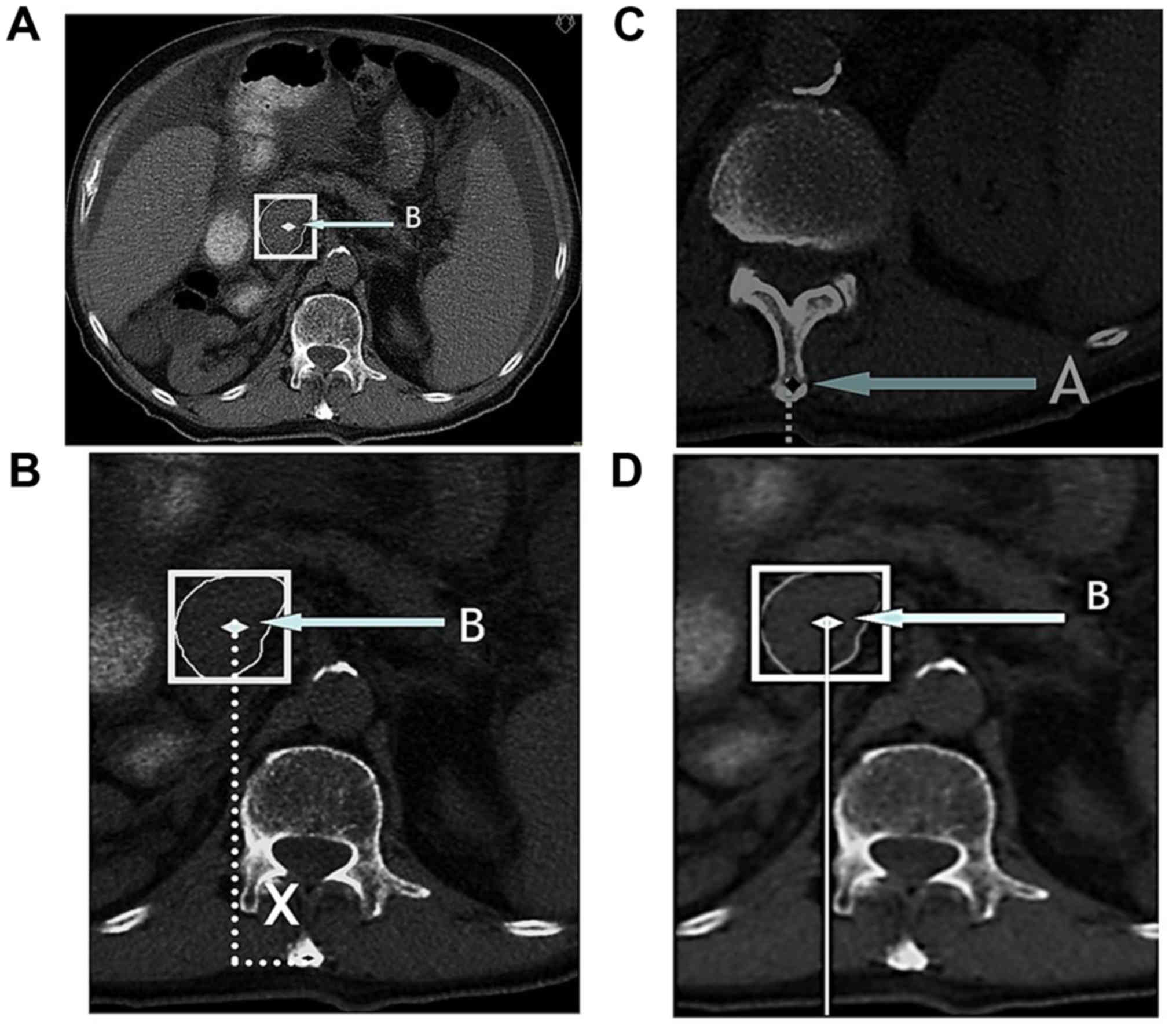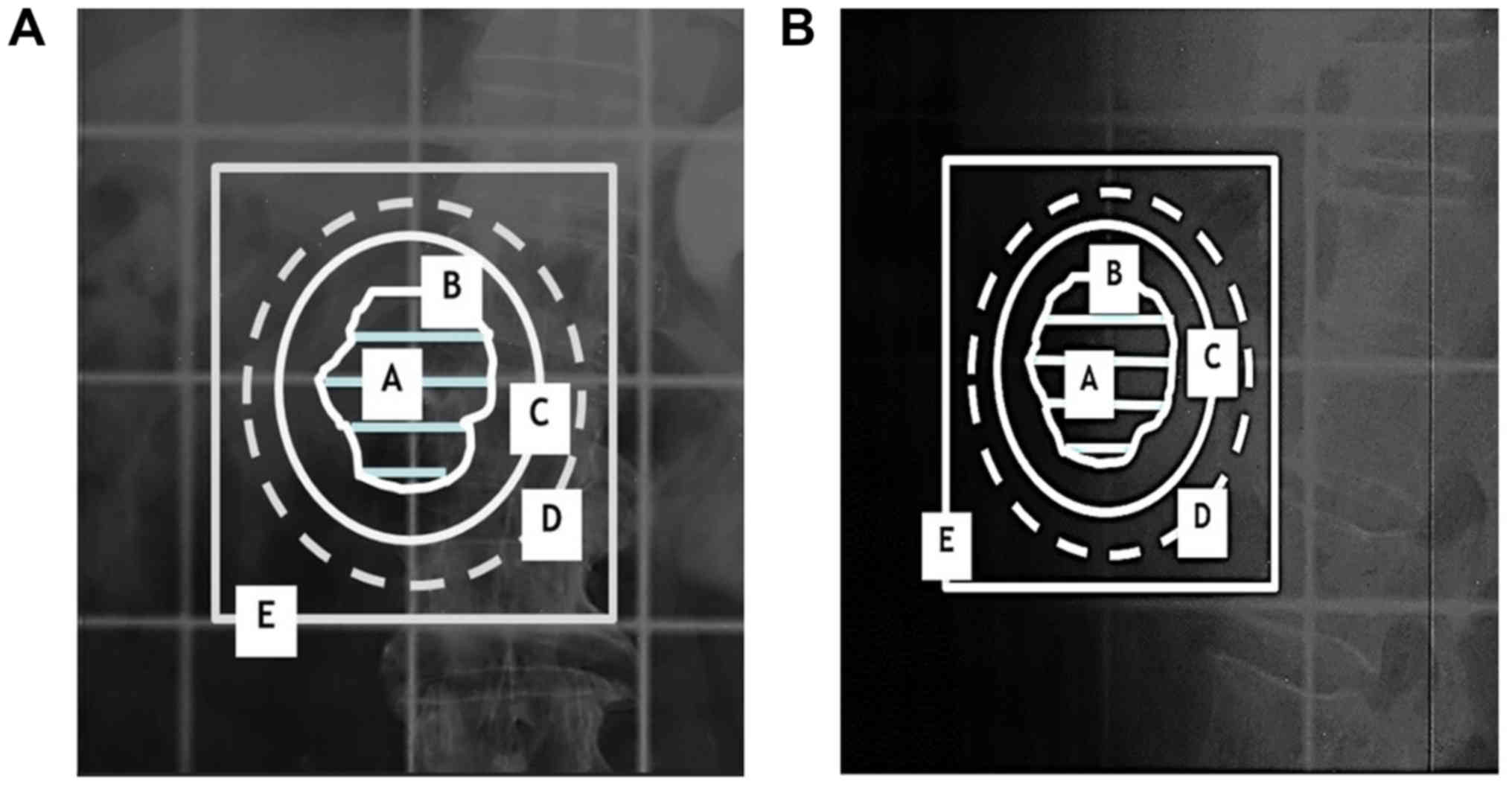Feasibility of 2D‑conformal radiotherapy for pancreatic carcinoma
- Authors:
- Published online on: September 4, 2018 https://doi.org/10.3892/ol.2018.9389
- Pages: 5939-5945
-
Copyright: © Buwenge et al. This is an open access article distributed under the terms of Creative Commons Attribution License.
Abstract
Introduction
Three-dimensional conformal radiotherapy (3D-CRT) has gradually developed and spread since the 90s. Currently this technique is the standard radiotherapy (RT) treatment in many centers worldwide. It is based on virtual simulation and requires three-dimensional treatment planning systems (3D-TPS) and linear accelerators equipped with multileaf collimators (MCLs) (1).
In several RT centers, especially in developing countries, 3D-CRT is not available and 2D-RT is still the only used technique (2). In 2014 an estimation of over 10,846 high-energy RT machines operating showed that 2,386 were still represented by cobalt units (3).
RT of pancreatic cancer (CaP) has been tested in recent decades in different settings (neoadjuvant, adjuvant, and palliative treatment) and nowadays is considered as a therapeutic option for CaP (4). However, RT in CaP is currently less used in developing countries due to technological limitations. In fact, in these centers RT fields are still planned with conventional simulators or a C-arm X-ray unit and the treatments are frequently delivered with cobalt machines. A precise targeting of CaP is difficult because these tumors are not visible on plain radiographs. In addition, 2D-RT is not able to produce an optimal and homogeneous dose distributions. This issue is particularly relevant in CaP, considering several organs at risk (OARs) such as spinal cord, duodenum, liver and kidneys that surround the pancreas.
Currently with the diffuse use of computerized tomography (CT) images now available in almost all centers and the conventional X-ray images produced by a simulator equipment. Therefore, theoretically we could hypothesis conformation of treatment fields by combination of extrapolated radiological information from the available images.
Based on these premises, the objective of this analysis was to propose an optimized planning technique for CaP. This technique is based on double simulation which resolves the problems of radiographic image distortion.
Materials and methods
Patients
In our center, 5 patients (2 female, 3 male) with locally advanced pancreatic head cancer undergoing RT treatment, aged 46 to75 years and with median body mass index of 23 (range: 21–29) were identified. Patients written informed consent for the use of their data and CT images to perform this analysis was sought prior. The Institutional Ethical Committee Board of High Technology Center for Research and Education (Campobasso, Italy) approved the study. Treatment planning was performed with 3 different methods: Standard two-dimensional (2D-SRT), three-dimensional-conformal (3D-CRT) and 2D-conformal (2D-CRT). In Table I, the characteristics of the 3 planning techniques are briefly summarized.
2D-SRT
Based on our previous analysis (5), a box-technique based on standard fields was tested. In short, the treatment was planned as follows: i) Standard fields were placed in reference to anatomical structures visible on X-ray images (vertebrae and the duodenum. The latter was opacified at the time of simulation with oral contrast medium; ii) fields sizes were adapted according to the beam energy as shown in Table II (Fig. 1A and B).
3D-CRT
Irradiation treatment plans were generated according to the standard processes of CT-simulation, target definition, and optimization of 3D dose distribution by using Dose Volume Histograms (DVHs) for Planning Target Volume (PTV) and Organs at Risk (OARs). Dose prescription was based on ICRU 62 indications (6).
2D-CRT
With correct patients' alignment in supine position, conventional simulation was performed. For anterior-posterior (AP) radiographs, the centering point was on the posterior end of the L1 spinous process [defined as point A] (Fig. 1C). Lateral view (LL) radiographs had their center at the same anatomical landmark (Fig. 1D).
CT scans with the patient in the same position for treatment reproducibility were performed (Table I), extending from T9 to L5 with an interval between scans of 5 mm. CT images were printed with a scale indicator display. The tumor had to be identified on all scans where it was visible. The scan displaying the center (in cranio-caudal direction) of the tumor was identified. The geometric center of the tumor [defined as the center of the rectangle circumscribing the visible tumor mass] (Fig. 2A) was indicated on this scan. This point was defined as point B.
Then, the distance in 3 dimensions (x, y, z) between point A and point B was calculated: i) The distance of point B from the center of the lumbar spine was measured, which corresponds to the lateral distance from point B to point A, if the patient is correctly aligned (distance x, Fig. 2B); ii) the cranio-caudal distance was calculated as the distance between the level of the scan in which point A and B were visible (distance y); iii) the antero-posterior distance was defined by measuring the distance between point A and B from the CT bed and then calculating their relative difference (distance z, Fig. 2C and D);.
Another simulation was then performed. Using the distances between point A and point B, the simulator table/bed with the patient was moved to align point B (center of the target) with the simulator isocenter. Two new X-rays centered at point B, one in the anterior-posterior projection and the other in lateral projection, were taken (Fig. 3A and B).
In consideration of the magnification factor, the Gross Tumor Volume (GTV) profiles at different scan levels were manually drawn (Fig. 3A and B). This profile defined GTV/Clinical Target Volume (CTV). Furthermore, PTV margins definition (14 mm cranial caudal direction and 11 mm in the radial direction, Fig. 3A and B) were added to the CTV. Another, margin of 10 mm to account for any inaccuracies in the profiles transfer from the CT images to the simulation radiographs was added to the PTV (Fig. 3A and B). The irradiation fields were obtained by adding an extra margin of 10 mm in cranio-caudal direction and 5 mm in the radial direction. Finally, a 2D dose distribution optimization was realized at the isocenter level only.
Comparison
Using a 3D TPS (Masterplan, Nucletron BV, Veenendaal, The Netherlands), 3D dose distributions and DVHs achieved with the 3 different treatment techniques were calculated using 10 MV photons beams. For 2D techniques, calculation of the dose distribution by a cobalt source was also performed. Finally, compliance with the dose-volume constraints (QUANTEC) obtained with the 3 different techniques were evaluated (7). This evaluation was performed by calculating a set of parameters for the main OARs and assuming two different PTV dose prescriptions (30 Gy in 3 Gy/fraction and 50 Gy in 2 Gy/fraction).
Results
Target irradiation
Using the 10 MV beam, the ICRU 62 indications were achieved in all patients (Dmin >95%, Dmax <107%) with all techniques (SRT-2D, 3D-CRT, CRT-2D) (Table III).
Using the cobalt source, both 2D techniques achieved PTV Dmin <95% and PTV Dmax <107% in all patients. However, a dose >95% of the prescribed was administered to >95% of the PTV (V95% >95%) in all patients (Table III).
OAR irradiation
Using the 10 MV beams, the duodenum and spinal cord Dmax were substantially similar using the 3 treatment techniques. In terms of liver and kidneys Dmean, there was a gradual improvement from 2D-SRT, 2D-CRT, and 3D-CRT technique. Furthermore, 2D-CRT, compared with 2D-SRT, halved liver Dmean and reduced to approximately 1/3 the kidney Dmean (Table III).
Using the cobalt 60 source beams, similar results in terms of spinal cord and duodenum Dmax with both 2D techniques were recorded. A marked dose reduction to the kidneys Dmean (from 30.7 to 16.9%) and liver (from 33.4 to 22.3%) were observed with 2D-CRT.
Dose-volume constraints
Tables IV and V show the results in terms of irradiation of the OAR, at the two different prescribed dose levels of 30 and 50 Gy, respectively. The duodenum, spinal cord and liver dose-volume constraints were always met, for any prescribed dose and with all used techniques. Regarding the kidney Dmean, only 10 MV photons with 30 Gy dose met the constraint in all patients, irrespective of the technique. At the same dose level, and by using the cobalt 60 source, only 2D-CRT respected the constraint Dmean <15 Gy in all patients, while exceeded this limit in one patient using 2D-SRT. Using the 50 Gy dose with 10 MV energy, 2D-CRT and 3D-CRT complied in all patients with the kidneys Dmean constraint. At the same dose level, with a cobalt source, neither of the two 2D techniques achieved a Dmean <15 Gy in all patients.
Discussion
In the past, different methods for 3D information transfer from CT scans to simulator X-rays were proposed (8–10). The interest in these solutions disappeared due to the spread of 3D-CRT based on CT-simulation, 3D-TPS and MCLs. However, 2D technology is still the only technique available in most developing countries. The lack of 3D-CRT in some centers, limits the use of RT especially in the treatment of malignancies requiring precision in target definition and OARs sparing.
In a previous study, we observed that with 2D-SRT, it is possible to meet the current standard dose-volume constraints (7) only by using lower total doses (30–36 Gy) (11). In a subsequent study, we defined the optimal fields size for involved-field irradiation of CaP with 2D-SRT technique (5).
In our current study, again CaP was used as a model for an optimized irradiation 2D technique (2D-CRT) feasibility for consistency. The main problem in the transfer of images from a CT slice to a simulator radiograph is the radiological image distortion depending on the beam projection. In the technique proposed in this study, this problem is solved by ‘double’ simulation. The GTV is drawn on a second simulated image where the machine isocentre is placed directly at the center of the target. This solution eliminates the problems of image distortion.
When we conducted a comparison between 2D-SRT and the two optimized CT information-based 3D-CRT and 2D-CRT techniques. The analysis showed that the latter technique can substantially improve the dosimetric results compared to 2D-SRT even with ‘standard’ RT doses (50 Gy) by a linear accelerator. Using a cobalt source, only a reduced dose (30 Gy) can be delivered by 2D-CRT. However, it should be noted that these types of accelerated-hypo-fractionated treatments (30 Gy, 3 Gy/fraction) were successfully used not only for palliation (12) but also in curative (13) and neoadjuvant (14) treatments.
As expected, the results of 2D-CRT were slightly lower compared to 3D-CRT. Probably, this difference was partially due to the additional margin to account for possible inaccuracies in the calculation of the distances between point A and point B (transfer error). In this analysis, to this margin was arbitrarily assigned a value of 1 cm. Prospective assessments on the extent of the ‘transfer error’ could allow an optimization of this margin.
It should be emphasized that using 2D-CRT technique is of utter most importance that the patient is properly aligned. This allows precise measurement of the distance between point A and B in the lateral direction.
Unfortunately, to achieve a wide spread of 3D-CRT technology in all RT centres in the world will require several years given the economic costs and logistic problems. In the meantime, the use of 2D-CRT technique may be useful to improve the quality of treatments in various anatomical sites even for centers in low and middle-income countries. Therefore, it could be useful to assess this method in RT treatment of other tumors. Furthermore, testing and clinical validation of the feasibility and reproducibility of this technique in the setting of developing countries is highly encouraged.
For these reasons, further studies have been planned in our center to evaluate 2D-CRT in the treatment of prostate cancer and in palliative treatments of advanced pelvic malignancies.
Acknowledgements
Not applicable.
Funding
No funding was received.
Availability of data and materials
All data generated or analyzed during this study are included in this published article.
Authors' contributions
MB, SaC, FD, GM, TW, AFMK, MAS and AGM were involved in the study conception and design. SaC, MB, SiC, VP, AA, EF, RF and AGM were involved in treatment planning, analysis and interpretation of the data. MB, FD, EF, RF, SaC and AGM drafted the article. TW, AFMK, MAS and AGM performed critical revision of the article for important intellectual content.
Ethics approval and consent to participate
Patients written informed consent for the use of their data and CT images to perform this analysis was sought prior. The institutional ethical committee board approved the study.
Patient consent for publication
Patients written informed consent for the use of their data and CT images to perform this analysis was sought prior.
Competing interests
The authors declare that they have no competing interests.
References
|
American College of Radiology: ACR practice parameter for 3D external beam radiation planning and conformal therapy. 2016.https://www.acr.org/-/media/ACR/Files/Practice-Parameters/3DConformal.pdfMarch 1–2018 | |
|
Zubizarreta EH, Fidarova E, Healy B and Rosenblatt E: Need for radiotherapy in low and middle-income countries-the silent crisis continues. Clin Oncol (R Coll Radiol). 27:107–114. 2015. View Article : Google Scholar : PubMed/NCBI | |
|
Page BR, Hudson AD, Brown DW, Shulman AC, Abdel-Wahab M, Fisher BJ and Patel S: Cobalt, linac, or other: What is the best solution for radiation therapy in developing countries? Int J Radiat Oncol Biol Phys. 89:476–480. 2014. View Article : Google Scholar : PubMed/NCBI | |
|
National Comprehensive Cancer Network: NCCN clinical practice guidelines in oncology: Pancreatic adenocarcinoma. Version 3. 2017.http://www.nccn.org/professionals/physician_gls/f_guidelines.aspMarch 1–2018 | |
|
Buwenge M, Marinelli A, Deodato F, Macchia G, Wondemagegnhu T, Salah T, Cammelli S, Uddin Kamal AFM, Sumon MA, Donati CM, et al: Definition of fields margins for palliative radiotherapy of pancreatic carcinoma. Mol Clin Oncol. 8:715–718. 2018.https://doi.org/10.3892/mco.2018.1605PubMed/NCBI | |
|
Morgan-Fletcher SL: Prescribing, recording and reporting photon beam therapy (Supplement to ICRU Report 50), ICRU Report 62. ICRU, pp. ix+ 52, 1999 (ICRU Bethesda, MD) $65.00 ISBN 0-913394-61-0. British Journal of Radiology. 74:294. 2001. View Article : Google Scholar | |
|
Bentzen SM, Constine LS, Deasy JO, Eisbruch A, Jackson A, Marks LB, Ten Haken RK and Yorke ED: Quantitative Analyses of Normal Tissue Effects in the Clinic (QUANTEC): An introduction to the scientific issues. Int J Radiat Oncol Biol Phys. 76 3 Suppl:S3–S9. 2010. View Article : Google Scholar : PubMed/NCBI | |
|
Cheng CW, Chin LM and Kijewski PK: A coordinate transfer of anatomical information from CT to treatment simulation. Int J Radiat Oncol Biol Phys. 13:1559–1569. 1987. View Article : Google Scholar : PubMed/NCBI | |
|
Flickinger JC and Deutsch M: Manual reconstruction of tumor volumes from CT scans for radiotherapy planning. Radiother Oncol. 14:151–158. 1989. View Article : Google Scholar : PubMed/NCBI | |
|
Rutten EH, Abma W and van Erning L: Digiplot: A PC programme for drawing tumor volumes for radiation therapy treatment planning using computer tomography images. Radiother Oncol. 24:117–119. 1992. View Article : Google Scholar : PubMed/NCBI | |
|
Morganti AG, Marinelli A, Buwenge M, Macchia G, Deodato F, Massaccesi M, Kigula-Mugambe J, Wondemagegnhu T, Dawotola D, Caravatta L, et al: Palliative two-dimensional radiotherapy of pancreatic carcinoma: A feasibility study. Tumori. 99:488–492. 2013. View Article : Google Scholar : PubMed/NCBI | |
|
Morganti AG, Trodella L, Valentini V, Barbi S, Macchia G, Mantini G, Turriziani A and Cellini N: Pain relief with short term irradiation in locally advanced carcinoma of the pancreas. J Palliat Care. 19:258–262. 2003.PubMed/NCBI | |
|
Crane CH, Abbruzzese JL, Evans DB, Wolff RA, Ballo MT, Delclos M, Milas L, Mason K, Charnsangavej C, Pisters PW, et al: Is the therapeutic index better with gemcitabine-based chemoradiation than with 5-fluorouracil-based chemoradiation in locally advanced pancreatic cancer? Int J Radiat Oncol Biol Phys. 52:1293–1302. 2002. View Article : Google Scholar : PubMed/NCBI | |
|
Pisters PW, Wolff RA, Janjan NA, Cleary KR, Charnsangavej C, Crane CN, Lenzi R, Vauthey JN, Lee JE, Abbruzzese JL and Evans DB: Preoperative paclitaxel and concurrent rapid-fractionation radiation for resectable pancreatic adenocarcinoma: Toxicities, histologic response rates, and event-free outcome. J Clin Oncol. 20:2537–2544. 2002. View Article : Google Scholar : PubMed/NCBI |












